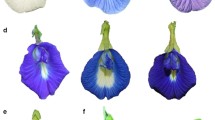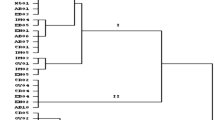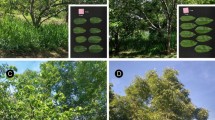Abstract
Butterfly pea, Clitoria ternatea is used in Africa as a companion crop and in the United States as an ornamental. The USDA, ARS, PGRCU curates 28 butterfly pea accessions. Butterfly pea accessions were transplanted from about 30-day-old seedlings to the field in Griffin, GA around 01 June 1999, 2003, 2006–2007 or directly sown in 2001. At 50% maturity, 19 accessions were characterized for morphology, phenology, and evaluated for regeneration. High quality plants regenerated from all accessions produced 6 to more than 3,400 total seeds. Butterfly pea can be successfully grown and regenerated in Griffin, GA. Coefficients of variation and principal component analysis revealed considerable variability among accessions for morphological and reproductive traits. Butterfly pea has potential to be used as a nutraceutical, pharmaceutical, or food. The flavonoid quercetin has been shown to reduce upper respiratory infections in humans while delphinidin and malvidin identified in butterfly pea flowers may inhibit various forms of cancer.

Similar content being viewed by others
References
Cook BG, Pengelly BC, Brown SD, Donnelly JL, Eagles DA, Franco MA, Hanson J, Mullen BF, Partridge IJ, Peters M, Schultze-Kraft R (2005) Tropical forages: an interactive tool [CD-ROM]. CSIRO, DPI&F(Qld), CIAT and ILRI, Brisbane, Australia
ECHO (2006) Butterfly pea. Educational concerns for hunger organization. http://www.echonet.org
Edible Flower. http://www.insidefitness.com/current190.html
Edwards RL, Lyon T, Litwin SE, Rabovsky A, Symons JD, Jalili T (2007) Quercetin reduces blood pressure in hypertensive subjects. J Nutr 137:2405–2411
Huang JL, Fu ST, Jiang YY, Cao YB, Guo ML, Wang Y, Xu Z (2007) Protective effects of nicotiflorin on reducing memory dysfunction, energy metabolism failure and oxidative stress in multi-infarct dementia model rats. Pharmacol Biochem Behav 86:741–748
ILDIS (1994) Plants and their constituents. In: Bisby FA (ed) Phytochemical dictionary of the Leguminosae. Chapman and Hall, New York, pp 1–748
Joson MT, Ramirez DA (1991) Cytology of Clitoria ternatea L. Philipp Agriculturist 74:121–132
Kotwal GJ (2007) Genetic diversity-independent neutralization of pandemic viruses (e.g. HIV), potentially pandemic (e.g. H5N1 strain of influenza) and carcinogenic (e.g. HBV and HCV) viruses and possible agents of bioterrorism (variola) by enveloped virus neutralizing compounds (EVNCs). Vaccine. Online ahead of print
Kou Y, Inaba H, Kato T, Tagashira M, Honma D, Kanda T, Ohtake Y, Amano A (2008) Inflammatory responses of gingival epithelial cells stimulated with porphyromonas gingivalis vesicles are inhibited by hop-associated polyphenols. J Periodontol 79:174–180
Lamy S, Blanchette M, Michaud-Levesque J, Lafleur R, Durocher Y, Moghrabi A, Barrette S, Gingras D (2006) Delphinidin, a dietary anthocyanidin, inhibits vascular endothelial growth factor receptor-2 phosphorylation. Carcinogenesis 27:989–996
Lau CS, Carrier DJ, Beitle RR, Howard LR, Lay JO, Liyanage R, Clausen EC (2005) A glycoside flavonoid in Kudzu (Pueraria lobata): identification, quantification, and determination of antioxidant activity. Appl Biochem Biotechnol 121–124:783–794
Malabadi RB, Mulgund GS, Nataraja K (2005) Screening of antibacterial activity in the extracts of Clitoria ternatea. J Med Aromat Plant Sci 27:26–29
Morris JB, Wang ML (2007) Anthocyanin and potential therapeutic traits in Clitoria, Desmodium, Corchorus, Catharanthus, and Hibiscus species. Acta Hortic 756:381–388
National Plant Germplasm System (2008) Germplasm resources information network (GRIN). Database Management Unit (DBMU), National Plant Germplasm System, U.S. Department of Agriculture, Beltsville
Nieman DC, Henson DA, Gross SJ, Jenkins DP, Davis JM, Murphy EA, Carmichael MD, Dumke CL, Utter AC, McAnulty SR, McAnulty LS, Mayer EP (2007) Quercetin reduces illness but not immune perturbations after intensive exercise. Med Sci Sports Exerc 39:1561–1569
Nothlings U, Murphy SP, Wilkens LR, Henderson BE, Kolonel LN (2007) Flavonols and pancreatic cancer risk: the multiethnic cohort study. Am J Epidemiol 166:924–931
Rao VS, Paiva LA, Souza MF, Campos AR, Ribeiro RA, Brito GA, Teixeira MJ, Silveira ER (2003) Ternatin, an anti-inflammatory flavonoid, inhibits thioglycolate-elicited rat peritoneal neutrophil accumulation and LPS-activated nitric oxide production in murine macrophages. Planta Med 69:851–853
Rogerio AP, Kanashiro A, Fontanari C, da Silva EV, Lucisano-Valim YM, Soares EG, Faccioli LH (2007) Anti-inflammatory activity of quercetin and isoquercitrin in experimental murine allergic asthma. Inflamm Res 56:402–408
Sawamura S, Sakane I, Satoh E, Ishii T, Shimizu Y, Nishimura M, Umehara K (2002) Isolation and determination of an antidote for botulinum neurotoxin from black tea extract. Nippon Yakurigaku Zasshi 120:116–118
Schaefer E, Peil H, Ambrosetti L, Petrini O (2003) Oedema protective properties of the red vine leaf extract AS 195 (Folia vitis viniferae) in the treatment of chronic venous insufficiency. A 6-week observational clinical trial. Arzneimittelforschung 53:243–246
Shimokawa K, Yamada K, Kita M, Uemura D (2007) Convergent synthesis and in vivo inhibitory effect on fat accumulation of (−)-ternatin, a highly N-methylated cyclic peptide. Bioorg Med Chem Lett 16:4447–4449
Singletary KW, Jung KJ, Giusti M (2007) Anthocyanin-rich grape extract blocks breast cell DNA damage. J Med Food 10:244–251
Srivastava A, Akoh CC, Fisher J, Krewer G (2007) Effect of anthocyanin fractions from selected cultivars of Georgia-grown blueberries on apoptosis and phase II enzymes. J Agric Food Chem 55:3180–3185
Zhang Y, Vareed SK, Nair MG (2005) Human tumor cell growth inhibition by nontoxic anthocyanins the pigments in fruits and vegetables. Life Sci 76:1465–1472
Author information
Authors and Affiliations
Corresponding author
Rights and permissions
About this article
Cite this article
Morris, J.B. Characterization of butterfly pea (Clitoria ternatea L.) accessions for morphology, phenology, reproduction and potential nutraceutical, pharmaceutical trait utilization. Genet Resour Crop Evol 56, 421–427 (2009). https://doi.org/10.1007/s10722-008-9376-0
Received:
Accepted:
Published:
Issue Date:
DOI: https://doi.org/10.1007/s10722-008-9376-0




